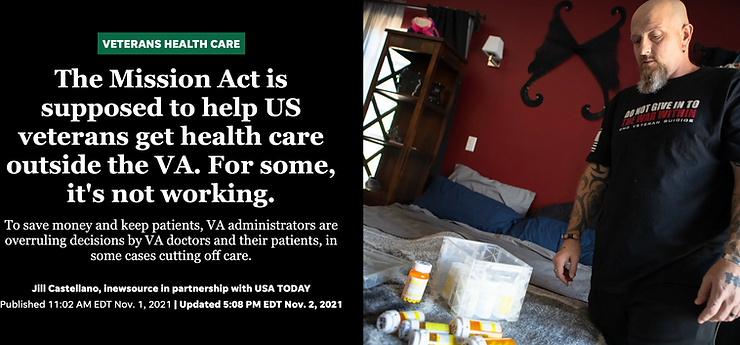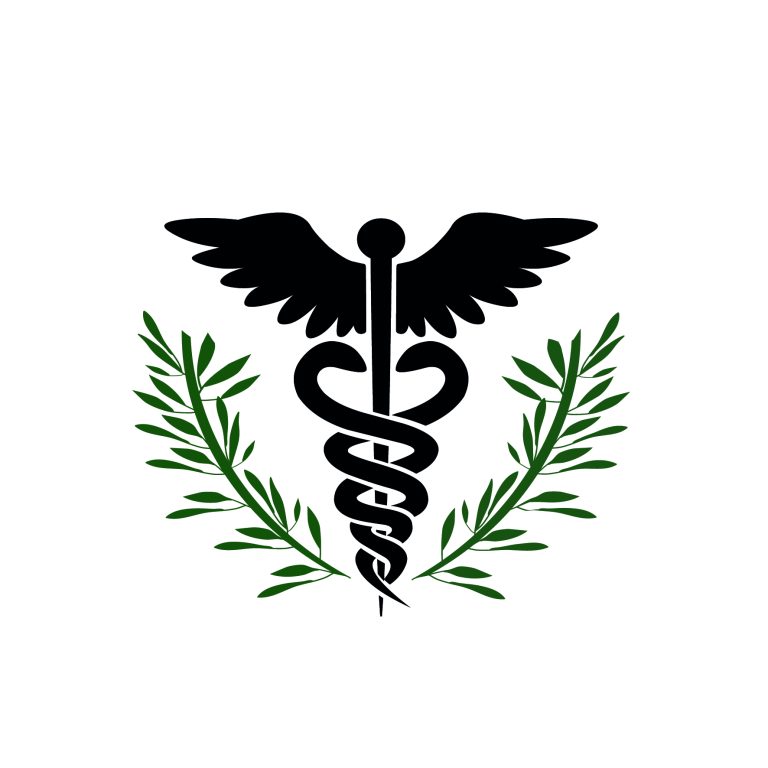Last week, USAToday ran a feature by reporter Jill Castellano that spotlighted issues around the VA MISSION Act, which is supposed to assure that veterans have easier access to care – outside the VA when clinically necessary.
The project was blatantly biased and had Koch fingerprints all over it. We hate to give it any extra attention but must correct the record.
The piece falsely accuses the VA of systematically denying veterans access to private sector care when it’s warranted. In truth, veterans are being referred to the private sector at acceleratingly high levels, as the aforementioned Hill op-edmakes clear.
Much of the story centers on the MISSION Act’s criteria of providing eligibility for private sector care for veterans “if it is in their best medical interest.” One of the veteran patients quoted in the piece gives an inaccurate definition of this criteria, saying veterans must be funneled out of VA “if they’re not getting all their needs met.”
That’s not remotely close to what the MISSION Act stipulated. More importantly, the notion that the best interest of the patient is decided by the patient is not only misguided but downright dangerous. Many patients, for instance, think it’s in their best interest to take antibiotics for a cold, or rely on opioids for the treatment of chronic pain. They may feel that the VA should pay for treatments that are dangerous, unproven, ineffective, or poorly monitored.
Castellano’s article also castigates VA officials for working to assure that the care veterans receive is highly coordinated and that veterans are protected from the kind of fragmentation of care that may result in preventable medical errors, injuries, or even death. Castellano depicts and dismisses VA’s concerns about the consequences of fragmented care as the obsession of callous, bureaucratic bean counters interested in saving money, not lives.
The opposite is true. Study after study has documented that the VA’s care coordination saves lives and leads to better outcomes. This is true of ER care, cancer care, diabetes care, and end stage renal disease. The New York Times, for one, has suggested that the VA’s life-saving suicide prevention algorithms provide lessons to other healthcare providers and systems.
As VHPI has repeatedly highlighted, care fragmentation is one of the most problematic aspects of non-VA care. It is a particularly acute issue for those with mental health and substance abuse problems, and those who are at high risk for suicide.
One analysis found the “costs of fragmentation” include “uncoordinated care, low adherence rates, and variations in sources of care.” Another said that “it is unclear how easier access to private sector care, potentially at the expense of increased fragmentation, could translate into safer higher-quality care, regardless of the cost implications.” Tragically, most patients don’t understand the dangers of fragmented care and may actually believe that seeing multiple healthcare professionals, none of whom communicate with one another, will enhance their care. In some cases, it can kill them.
Castellano’s reporting is compromised by her reliance on a limited roster of sources. The article depends heavily, for instance, on Darin Selnick, a VA privatizer with close ties to the Trump and Koch worlds, as well as a newly launched anti-VA think tank, the Veterans 4 American First Institute. Selnick inaccurately contends that regulations allow for veterans to access private care whenever “it’s best for you.” In truth, MISSION didn’t do away with VA’s oversight of authorized care, as much as Selnick wishes it had.
What is most interesting about Selnick’s contributions to this article is his critique of the Congressional legislation and VA-implementation standards that he helped write. Indeed, almost all of the alleged shortcomings that Castellanoand Selnick attribute to Biden’s VA leadership, were created by Trump’s second VA Secretary, Robert Wilkie.
Castellano also has multiple quotes from Congressman Michael Bost, ranking member of the House Committee on Veterans Affairs and another promoter of VA privatization. After VA clinicians and administrators express legitimate concerns about the ballooning cost of private care, Bost insincerely responds that, “If they have a problem with the budget, they need to come and talk to Congress.” Castellano neglects to mention that Bost has repeatedly torpedoed positive legislative efforts, like the EVEST Act , because of cost. “We can’t just throw money at the VA” is his literal mantra.
Had Castellano interviewed a broader range of sources — like, for example, Mark Takano, the Chairman of the House Committee on Veterans Affairs, who represents a Southern California district near San Diego – as well as respect healthcare experts, the story would have been more far less biased.
That this USAToday project is heavily biased should come as no surprise. The paper has become a major outlet for VA bashing. It was once the go-to outlet for Takano’s predecessor, a Tea Party Congressman named Jeff Miller. (Miller was the architect of the first major VA outsourcing law, the Choice Act, and now lobbies for private VA contractors.) In 2016, USAToday’s Donavan Slack attacked then-VA Secretary Bob McDonald for comments he made to another reporter suggesting , in the wake of news about care delays that the VA take a lessor or two from Disney. Slack insisted that it was inappropriate for McDonald to compare healthcare to going to a Disney property. (Unacknowledged in this brouhaha: Disney’s corporate model for gauging customer satisfaction is widely used in private healthcare to determine patient satisfaction and regulate the patient experience.)
In June 2018, Slack teamed up with the Boston Globe Spotlight team to publish an article with the inflammatory title: “Secret VA nursing-home ratings hid poor quality are from the public.” Reporters Andrea Estes and Slack claimed that 60 of the VA’s 133 nursing homes received the lowest ratings. As VHPI experts wrote in a correction of the article’s many inaccuracies:
The article fails to help the reader understand how experts judge the overall quality of nursing homes. There is an overall rating, a rating based on the survey deficiencies, a rating on staffing, and a rating on resident quality measures. The average VA nursing home has an overall rating of 3.4, which is better than the national average and they have a 3.0 rating on deficiencies, which is the national average…The article did not consider the single most important measure on which experts judge nursing home quality – nurse staffing. The VA had an almost a perfect score, 4.95, on high nurse staffing.
It’s far beyond the time for USAToday to get its facts straight. We encourage reporters to dig into and expose VA issues. Accountability leads to improvements in care. Yet cynical framing intent on damaging the department’s reputation does little more than misinform readers and make the VA a less desirable employer for the countless staffers – a third of whom are vets – who work tirelessly every day to meet its lofty mission.



